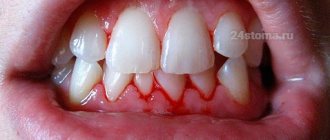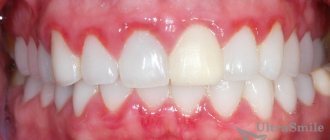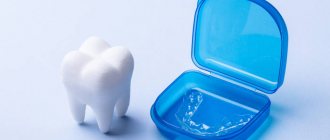Why do my gums bleed?
If you begin to notice traces of blood in the sink after brushing your teeth, you should not think that the unpleasant phenomenon will go away on its own. This alarming symptom may signal that some pathological process is developing in the oral cavity, even if bleeding gums are not yet accompanied by pain or other discomfort.
Try to remember if you have recently chewed on something hard, brushed your teeth too hard with a new hard-bristled brush, or done any other activity that could have injured soft tissue. If discomfort in the oral cavity is not associated with mechanical damage, it is worth thinking about whether you are careful enough about your hygiene. Hard and soft plaque accumulating in the subgingival area is one of the most common answers to the question of why gums bleed. Ignoring the problem aggravates the situation and leads to the appearance of periodontal pockets, which are an ideal “storage” for various types of deposits. Coupled with dental caries, all this leads to damage to the mucous membrane and inflammatory processes.
Whatever factors lead to the appearance of unpleasant symptoms, the first step is to consult a doctor.
We asked dentist-therapist Anzhelika Guryeva to elaborate on the possible causes of bleeding gums.
- Stomatitis manifests itself as hypersalivation (excessive salivation), the appearance of a white or yellowish plaque, bad breath and the appearance of painful ulcers on the mucous membrane, which interfere with normal eating and sometimes speaking. Redness, discomfort and other unpleasant symptoms may be the result of improper or insufficient oral care, and may also indicate more global problems in the functioning of the body as a whole: decreased immunity, problems with the gastrointestinal tract or allergic reactions.
- Gingivitis. This unpleasant disease is an inflammatory process in the mucous membrane, manifested by swelling, redness, pain and bleeding. If you do not consult a dentist in time, there is a high risk that advanced inflammation will penetrate deeper into the soft tissues and ultimately lead to periodontitis.
- Periodontitis occurs when the patient does not go to the dentist in time and the inflammatory process begins to grow deeper and reaches the periodontal tissues. This unique structure that surrounds the tooth and holds it in the alveolus has the ability to regenerate, but only if it has not gone too far. Alas, periodontitis is precisely the case when a complete cure is not possible, so it is better not to go to extremes and undergo preventive examinations with a dentist on a regular basis, even if nothing bothers you, not to mention cases when the patient’s gums are bleeding when brushing your teeth. But still, don’t despair. Anzhelika Alekseevna is encouraging that modern medicine offers a sufficient number of techniques that make it possible to achieve stable remission, but you will have to prepare for long-term complex treatment. Among the main symptoms of periodontitis, our expert names the following:
- pain during eating, which is aching in nature;
- bleeding gums;
- redness in the area of gingival papillae - small visible areas between the teeth and gums;
— an unpleasant odor caused by the process of decay of deposits in periodontal pockets at the junction of the tooth and gum;
- decreased gum level;
- reduction in the volume of gum tissue;
- gradual destruction of bone tissue;
- the period of exacerbation is characterized by weakness, fever and poor health in general;
- in advanced cases, loosening and subsequent loss of teeth are observed.
Attention! Anzhelika Guryeva: “The appearance of at least some of these symptoms should alert you and become a good reason to seek professional diagnosis.”
- Mechanical damage. Sometimes the cause of bleeding gums is not serious dental problems, but a simple injury. Can’t wean yourself from the bad habit of chewing the tip of a ballpoint pen, or do you like to indulge in crackers or seeds in your spare time? Then you shouldn’t be surprised if you find blood in your mouth. In addition, poorly installed fillings, dentures and crowns can injure the delicate mucous membrane. Orthodontic clients also face this problem when they first wear braces. Even if you know exactly at what point and how you damaged the soft tissues, Anzhelika Alekseevna recommends that you definitely see a dentist in order to properly treat the scratch and prevent infection.
- Malfunctions of the body. It happens that bleeding gums is a reason to contact not only specialized specialists, but also doctors of other specialties. A comprehensive assessment of your overall health will help identify the root of the problem and avoid many troubles in the future. Our expert identifies the following system-wide disorders that can give rise to the development of dental problems:
— Acute lack of vitamins. First of all, bloody traces in the sink indicate that there is not enough vitamin C in the body.
- Smoking. Nicotine has a negative effect on the walls of blood vessels, weakening them.
- Bleeding gums during pregnancy are explained by hormonal changes that weaken blood vessels.
- Oncology.
- Hemophilia. With this disease, the blood clotting function is impaired.
- Diabetes.
- Liver problems.
— Infections and viruses
- Diseases of the immune system.
- Taking medications. Some medications designed to thin the blood to prevent blood clots have a number of side effects, including bleeding. Most often, the problem resolves itself after stopping the medication.
pixabay.com/mohamed_hassan
Types of gingivitis in children
So that the doctor can create the most complete picture, there are several classifications of the disease. Each type has its own clinical characteristics, methods of care and arises due to various factors. After treatment, strict monitoring is required to avoid relapse. This is especially true for children, because they are not able to carry out hygiene and other procedures on their own, so all the doctor’s recommendations fall on the parents.
Catarrhal
It is associated with age-related changes. Most often occurs during primary eruption or in the presence of a concomitant infectious disease. It can be recognized by pain when eating and bleeding when cleaning. An unpleasant odor and loss of taste sensitivity appear. The child may complain of burning and itching in the mouth. On examination, you can see redness.
Marginal
Most often observed in children with abnormal dentition and malocclusion. Because of this, it may be impossible to thoroughly clean all hard-to-reach places where plaque begins to accumulate and pathogenic microflora multiply. Bleeding is noticeable, and in the early stages there is virtually no pain or redness. The attachment of the gums to the teeth is not disturbed. In advanced cases it can become chronic.
Desquamative
The appearance is associated with hormonal disorders and most often occurs during puberty. May occur against the background of other diseases:
- lichen planus;
- pemphigus vulgaris;
- permanent infections.
In the early stages, other than bleeding during cleaning, no symptoms are observed. During the transition period, the gums swell greatly and acquire a bright shade and shine. In complex and advanced cases, purulent ulcers and erosion appear.
Hypertrophic
A complicated form that occurs against the background of a long-term inflammatory process that has entered the chronic stage. The redness will be pronounced, it is impossible to miss or not notice it during examination. The taste of food will be practically lost due to constant bleeding and the taste of blood in the mouth.
Ulcerative
Appears if there has already been primary inflammation in the oral cavity - stomatitis. Concomitant factors include severe hypothermia and decreased immunity. At the same time, the child’s condition worsens sharply; he feels pain in his gums and cannot swallow. Due to the inflammatory process, not only the gum tissue, but also the tonsils can swell. Upon examination, you can see ulcers with a serous putrefactive coating.
Atrophic
It often manifests itself as a medical error during poor-quality orthodontic treatment. An abnormal attachment of the frenulum may also be a provoking factor.
The child's condition will be stable, there are practically no signs of inflammation. You may notice only mild redness, exposed teeth and increased sensitivity to hot foods.
Why do my baby's gums bleed?
Not only adults, but also children face the problem of bleeding and inflammation of the gums. In general, the reasons for this unpleasant phenomenon are approximately the same. Stomatitis, gingivitis, periodontitis, general functional disorders, mechanical damage, vitamin deficiency, infections and uncomfortable braces can bother both adults and young patients. The only case when blood in a child’s mouth is normal is during the period when milk teeth are replaced by molars. A loose tooth naturally injures the gums. In any case, if you have any doubts, take your child to see a specialist.
Symptoms of gum inflammation in a child
Symptoms of gum disease vary depending on the type and form of the disease. These include:
- bleeding and pain;
- unpleasant odor from the mouth;
- purulent discharge;
- deposits of plaque or tartar;
- hypersensitivity.
Most often, childhood gum disease is associated with the development of gingivitis. The inflammatory process occurs due to poor oral hygiene (bacteria multiply).
REFERENCE! If you have problems with your gums, a visit to the dentist is required. Only a specialist will select an individual treatment algorithm based on the symptoms.
Diagnostics
Treatment of absolutely any disease begins with diagnosis. Anzhelika Guryeva especially emphasizes that in dentistry, as in other areas of medicine, a differentiated approach to the problem is more important than ever: “A comprehensive examination will help to understand what exactly was the “trigger” - poor hygiene or pathological disruptions in the body.”
To make a correct diagnosis and prescribe adequate treatment, it is necessary to carry out a whole range of diagnostic measures:
— the doctor collects anamnesis during a personal conversation with the patient regarding symptoms that bother him;
- after this, the specialist examines the oral cavity to determine the depth of the periodontal pockets and the amount of deposits accumulated in them and to understand how far the process has gone;
— computed tomography allows you to accurately assess the degree of periodontal damage, if any;
— if necessary, the patient will be asked to additionally donate blood for sugar, hormones and lack of vitamins and microelements.
pixabay.com/Semevent
What to do if there is bleeding?
It is not difficult to find out that the gum is healthy - it has a brown or pink tint, and there should not be any wounds or scratches on it. In case of bleeding, swelling or anything else, you need to seek help from a specialist. After all, gums can bleed for internal reasons; you certainly won’t be able to identify them yourself. Once the cause of the problem is identified, an individual treatment plan is drawn up, which may include a variety of therapeutic methods. Effective ways to get rid of bleeding gums when brushing your teeth at home:
- Apply a cold compress to the bleeding site; a piece of ice wrapped in gauze is ideal;
- Use available antiseptics, such as hydrogen peroxide, moisten a cotton swab and treat the gums;
- It is worth noting that if there is a suspicion of an inflammatory disease, it is better not to self-medicate, as there is a risk of only worsening the situation.
How to treat bleeding gums
After a comprehensive diagnosis has been carried out and the root cause of the disease has been identified, it’s time to begin treatment, which will probably take place in several stages. Be prepared for the fact that the therapy will take a lot of time, but the result in the form of strong and healthy gums will certainly please you.
Dentist-therapist Anzhelika Guryeva told how the treatment process will roughly go.
- Professional hygiene. This step is absolutely necessary to get rid of hard and soft plaque, which contributes to the growth of bacteria in the oral cavity. Strictly speaking, even in the absence of pronounced problems, each person needs to undergo the procedure once every six months. Comprehensive cleaning, taking into account an individual approach to each specific case, allows you to achieve impressive results: the condition of the mucous membrane is normalized, inflammation is relieved, bleeding goes away, and the enamel is whitened. The following common professional care techniques exist:
—Teeth cleaning using ultrasound. A special device - a scaler - destroys solid deposits. The simultaneous supply of water does not allow the enamel to overheat and washes away all excess.
- Air abrasive cleaning. It can be used independently, but the best result can be achieved after removing tartar with ultrasound or laser. A jet of water with tiny cleaning particles under pressure cleans the spaces between the teeth, penetrating into the most difficult to reach areas.
- Polishing. The smallest pores of tooth enamel and fillings tend to absorb harmful bacteria and color pigments. The specialist treats the top layer of teeth using a rotating brush with an abrasive paste applied to it.
- Fluoridation. Applying a special gel helps strengthen tissues and relieve excessive sensitivity. In order not to wash off the protective barrier, it is recommended to refrain from eating and drinking for at least an hour after the session.
- Gum treatment. After removing the deposits, the condition of the gums will inevitably improve, and the inflammation will go away naturally, however, it will not be superfluous to additionally apply a soothing solution in the form of a gel to the soft tissues. The composition will speed up recovery, and the installation of an absorbable barrier membrane with extracts of medicinal plants will restore elasticity and a healthy appearance to the mucous membrane.
- Unfortunately, relatively mild methods of influence are not always effective enough, especially if the disease has progressed to an advanced form. In this case, the doctor will remove the accumulations from the periodontal pockets using open or closed curettage. The first option is less traumatic, but is not suitable for deep cavities. In the second case, an incision is made through which all excess is cleaned out, after which sutures are applied.
- Elimination of inflammation. As a rule, it takes about 10 days to completely relieve the inflammatory process. Treating bleeding gums at home involves regular rinsing with antiseptic and anti-inflammatory compounds and applying special ointments. Irrigation of the oral cavity with decoctions of medicinal herbs gives good results. Important! All your actions must be agreed with your doctor! Amateur activity is unacceptable here!
- Restoration of affected areas of bone tissue. If it was not possible to stop the process in time and the development of periodontitis has led to partial loss of one’s own bone tissue, during open curettage it is possible to replenish the affected areas with the help of artificial materials.
- Specialized care. The dentist involved in your treatment will definitely help you choose the right toothpaste for daily care, containing extracts from medicinal plants and herbs, as well as minerals and other useful components.
- Toothbrush. If on normal days you use a product of medium or strong hardness, then during treatment, change the bristles to soft ones, which will provide mechanical sparing to the enamel and gums.
- Vitamin complexes. If you have not yet been tested for vitamin deficiencies, do so as soon as possible. Bleeding gums may indicate vitamin deficiency. However, keep in mind that you can go to the pharmacy for multivitamins only after receiving test results and consulting with your doctor.
pixabay.com/Engin_Akyurt
Gingivitis: treatment and prevention in children
Gingivitis, like any other disease of the teeth and gums, is easier to prevent than to cure. The surest way to prevent it is regular and proper oral care. It is in the mouth that pathogenic bacteria multiply, causing inflammation of the mucous membrane.
Tips for maintaining oral hygiene in children:
- Monitor how your child brushes their teeth. For children under two years old, it is better to carry out this procedure yourself. Remember that the movements of the toothbrush should be “sweeping” - from the base of the gums to the top of the tooth.
- Feed your child healthy, balanced foods. A sufficient amount of protein, fiber and minerals in your baby’s diet will protect him from gum disease. Limit your consumption of sweets and starchy foods.
- If your child has an abnormal bite or abnormal growth of teeth, including crowded or missing teeth, be sure to consult a specialist. Insufficient load or, conversely, overload of teeth and gums can cause gingivitis.
- Use soft toothbrushes with even bristles. Change them regularly - dentists recommend buying a new toothbrush once every three months.
- Be sure to choose toothpaste according to the child’s age.
Don't skimp on teeth and gum care products. After all, treatment will cost much more. An excellent choice is the ASEPTA children's toothpastes; they are available in three versions:
- for children from 0 to 3 years;
- from 4 to 8 years;
- for children over 8 years old.
The composition of each of these pastes fully meets the needs of children's teeth in each age period. They contain calcium in the form of lactate - this is the most easily absorbed form. Children's enamel will not lack this mineral. And the xylitol contained in the paste, a “tooth-friendly” sugar, gives it a sweet, pleasant taste. Unlike adult products, the ASEPTA BABY series does not contain excessive amounts of fluoride and menthol additives.
How to treat gingivitis in children
If you cannot avoid the disease, you must urgently seek help from a dentist. In any case, if you find redness of the gums, swelling or soreness of the mucous membrane, you should consult a specialist. Only a doctor can prescribe treatment. In addition, it is best to begin the fight against this disease by removing plaque and tartar, but this is impossible to do at home.
If you find that your child has red, swollen gums, or if the baby complains of pain in the mouth, be sure to visit the dentist in the coming days. Only a specialist will make an accurate diagnosis and prescribe the right treatment. Don't delay going to the doctor - the situation may get worse!
It is impossible to get rid of gingivitis at home, since gum inflammation can be caused by several reasons, including dental caries, tartar, and others. Before going to the dentist, prepare your child mentally:
- tell us how the dental examination will go;
- do not scare the baby, do not say that it will “not hurt” or “not be scary” - the child may begin to be afraid only because of your words;
- Watch cartoons with your child about going to the dentist.
Pay close attention to creating a menu for your baby during illness. Try to completely eliminate hot and cold foods and drinks, replacing them with warm ones, and also increase the amount of microelements and vitamins (especially groups A, B, C, D) supplied with food, or introduce them additionally into the diet.
If gingivitis is caused by constant mechanical injuries to the mucous membrane, change the child’s toothbrush and stop him from chewing pencils and other objects.
Also teach him how to brush his teeth properly. To do this, you can watch special training videos, which show in a playful way what movements need to be made when cleaning. Regular dental hygiene is the basis for the prevention of any oral diseases.
Gingivitis in children due to weakened immunity is treated etiologically - that is, the main efforts should be aimed at eliminating the cause of the underlying disease. So, if a child often suffers from ARVI or influenza, his diet should be balanced, vitamins, minerals, and lactic acid products should be included. Perhaps you should take more walks in the fresh air.
If your child is experiencing chronic stress, reconsider his daily routine. Perhaps you should give up some clubs or developmental activities, stop going to kindergarten for a while, spend more time with your baby, and reduce the demands on him from teachers or educators. All these measures can help reduce stress and boost the child’s immunity, which, in turn, will prevent gum disease.
Prevention
It's no secret that any disease is easier to prevent than to treat for a long time and painfully. Bleeding gums are no exception. Angelica Guryeva explained what needs to be done to maintain the health of the mucous membrane. The entire prevention system in this case is based on taking care of the cleanliness of the oral cavity.
- Ask your dentist to choose a toothpaste and brush that suits your individual needs.
- Brush your teeth at least twice a day.
- After each meal, use dental floss and rinse your mouth with special rinses or at least plain water.
- Buy an irrigator - a device for more thorough cleaning of teeth and hard-to-reach areas of the oral cavity.
- Eat right. Include foods rich in fluoride and calcium in your diet.
pixabay.com/mohamed_hassan
Visit the dentist on time and be healthy!
Causes of childhood gingivitis
This disease is quite common in children, including preschoolers and children of primary school age. Dentists call the main causes of gingivitis:
- accumulation of plaque on teeth (bacteria multiplication is observed when plaque is 1-5 days old);
- inadequate load on teeth and gums - reduced or, on the contrary, increased. This is typical for malocclusion pathology, uneven tooth growth, and crowding;
- mechanical trauma to the gum mucosa, including improper brushing of teeth, use of a brush with hard bristles, inept handling of dental floss;
- a general decrease in the child’s immunity due to acute respiratory viral infections, influenza, hypovitaminosis, and stress.
Gingivitis often occurs in combination with stomatitis, which increases pain and complicates the treatment of the disease.
Treatment of bleeding gums
If you notice any of the above symptoms, make an appointment with your dentist. The doctor will first check how you practice oral hygiene, whether you have any bad habits and how you eat. Smoking is extremely harmful to teeth: tobacco smoke destroys the protective film on the periodontium, which allows bacteria to freely penetrate and destroy the gums. Insufficient or improper hygiene can also cause damage to the periodontium. For example, if you use a brush that is too hard or press hard on it while brushing your teeth.
Treatment for bleeding gums begins with correcting hygiene. The dentist will select the right toothbrush, toothpaste and mouthwash for you. Prevention of gingivitis and periodontal disease will help eradicate the problem at the initial stage and prevent it from developing. As a rule, when your gums bleed, you need to abandon whitening pastes in favor of special ones for sensitive teeth; the bristles of the brush should be soft.
The next stage of gum treatment will be ultrasonic teeth cleaning to get rid of plaque and hard deposits. The doctor will also examine foci of infection and eliminate caries, if any. If a tooth bleeds due to a filling or crown, sharpening is performed.
To relieve inflammation of the gums, the doctor will prescribe rinses and gels. Most often, chlorhexidine solution is prescribed for rinsing, which is sold in any pharmacy. If the inflammatory process is accompanied by the release of pus, antibiotics are added to the course of therapy.
In advanced cases of periodontal disease, treatment of bleeding gums is carried out by a periodontist. He heals the resulting pockets around the tooth or performs extraction and subsequent implantation, depending on the specific case. Pockets wider than 4 mm are almost impossible to seal, so in some situations it is better to remove a loose tooth and insert an implant. You can make an appointment with a periodontist in Krasnoyarsk at the Apex dental clinic.











